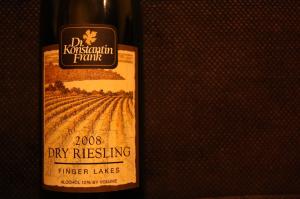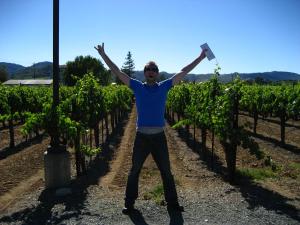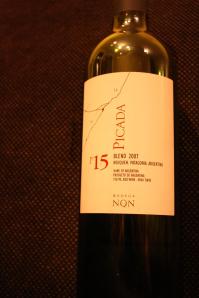 Cooking is the one pleasure I deny myself most often in this busy life. We all know the satisfaction of making a meal from scratch. Usually there will be some initial resistance, remnants of an “I don’t wanna!” attitude I’ve kept towards cooking for no good reason – then out come the pans, the butter, the pepper and salt. While water boils, tomato sauce simmers; spaghetti strands soften and curl. At the end of the day, it all amounts to beans (or noodles, or rice and beans on a tortilla, or hummus). The worst mood can be banished with the right food, and the right glass of wine to make that food shine. Appreciation is the key.
Cooking is the one pleasure I deny myself most often in this busy life. We all know the satisfaction of making a meal from scratch. Usually there will be some initial resistance, remnants of an “I don’t wanna!” attitude I’ve kept towards cooking for no good reason – then out come the pans, the butter, the pepper and salt. While water boils, tomato sauce simmers; spaghetti strands soften and curl. At the end of the day, it all amounts to beans (or noodles, or rice and beans on a tortilla, or hummus). The worst mood can be banished with the right food, and the right glass of wine to make that food shine. Appreciation is the key.
So this is a post about spaghetti and meatballs. But what are spaghetti and meatballs, really? A platform for Chianti. You didn’t know this? Don’t care. It’s true. Anyone who wants to understand my reasoning will need an understanding of Chianti. Here goes.
 Chianti is a red still wine produced in a region by the same name (Chianti) in Tuscany, Italy. The region is designated by a Denominazione di Origine Controllata (DOC), which guarantees certain methods of production: set yields, vinification practices, grape types, and production methods. Chianti is primarily made with Sangiovese – at least 75%. Sangiovese is a fun grape, with characteristics that make it perfect as a companion to food: nice acidity, earthiness, and fruit ranging from bright to dark. Younger Chianti tends to show lots of fresh raspberry fruit with notes of sage and spice, complete with sharp but not searing acidity, while older Chianti (such as a Riserva) is generally much more complex and balanced, with blackberry and other dark fruit balanced by earthy components such as leaves, cocoa, and floral or mineral notes. Sangiovese has a number of clones (genetic offshoots that exhibit distinct flavor profiles), and also displays different flavors and aromas depending on the amount of aging the wine sees. Besides being the source of Chianti, it is also the only grape varietal permitted in the prestigious Brunello di Montalcino (Chianti’s brooding older sibling, made from the Brunello clone). Other grapes permitted in Chianti include up to 10% Canaiolo and up to 20% of a few other red grapes: Cabernet Sauvignon, Merlot, or Syrah. The use of white grapes like Trebbiano has been prohibited for Chianti Classico.
Chianti is a red still wine produced in a region by the same name (Chianti) in Tuscany, Italy. The region is designated by a Denominazione di Origine Controllata (DOC), which guarantees certain methods of production: set yields, vinification practices, grape types, and production methods. Chianti is primarily made with Sangiovese – at least 75%. Sangiovese is a fun grape, with characteristics that make it perfect as a companion to food: nice acidity, earthiness, and fruit ranging from bright to dark. Younger Chianti tends to show lots of fresh raspberry fruit with notes of sage and spice, complete with sharp but not searing acidity, while older Chianti (such as a Riserva) is generally much more complex and balanced, with blackberry and other dark fruit balanced by earthy components such as leaves, cocoa, and floral or mineral notes. Sangiovese has a number of clones (genetic offshoots that exhibit distinct flavor profiles), and also displays different flavors and aromas depending on the amount of aging the wine sees. Besides being the source of Chianti, it is also the only grape varietal permitted in the prestigious Brunello di Montalcino (Chianti’s brooding older sibling, made from the Brunello clone). Other grapes permitted in Chianti include up to 10% Canaiolo and up to 20% of a few other red grapes: Cabernet Sauvignon, Merlot, or Syrah. The use of white grapes like Trebbiano has been prohibited for Chianti Classico.
Chianti Classico is considered the finest appellation (production zone with a legally-defined boundary) in the Chianti region, a 100 square mile region with Denominazione di Origine Controllata e Garantita (DOCG) status – theoretically superior in quality – near Florence; however, nice wines can also be found in Chianti Rufina, another appellation. Chianti Classico must have a minimum alcohol level of at least 12%, and must go through at least seven months aging in oak, while Chianti Classico Riserva must be aged for at least 27 months at the winery, with a minimum alcohol level of at least 12.5%.
 The subject of today’s post, the 2008 Loggia del Conte Chianti, is a far more modest fine, only provided with DOC status. Made with 100% Sangiovese, it has what wine drinkers refer to as typicity – the flavors and aromas are true to what would be expected of the grape. A nice garnet color, it’s just a bouncy, fruity, accessible Chianti with cherry fruit jumping out of the glass, some mineral and baking spice notes, and good acidity. Red sauce’s best friend. $8 a bottle. I recommend this wine to people as ideal for spaghetti and meatballs: the acidity cuts through any meat sauce, but the wine is in a softer style, so it doesn’t come across as lean to the point of meanness. Quick finish, but you will have moved on to your next bite anyhow. We paired this wine with (surprise) spaghetti and meatballs: the red sauce was perfect, with garlic, basil and oregano and crushed fire-roasted tomatoes, with meatballs I made by hand out of pork and beef with Worcestershire sauce, garlic, oregano, basil, salt, pepper, egg, seasoned breadcrumbs and shredded Parmesan cheese. Appreciation is the key.
The subject of today’s post, the 2008 Loggia del Conte Chianti, is a far more modest fine, only provided with DOC status. Made with 100% Sangiovese, it has what wine drinkers refer to as typicity – the flavors and aromas are true to what would be expected of the grape. A nice garnet color, it’s just a bouncy, fruity, accessible Chianti with cherry fruit jumping out of the glass, some mineral and baking spice notes, and good acidity. Red sauce’s best friend. $8 a bottle. I recommend this wine to people as ideal for spaghetti and meatballs: the acidity cuts through any meat sauce, but the wine is in a softer style, so it doesn’t come across as lean to the point of meanness. Quick finish, but you will have moved on to your next bite anyhow. We paired this wine with (surprise) spaghetti and meatballs: the red sauce was perfect, with garlic, basil and oregano and crushed fire-roasted tomatoes, with meatballs I made by hand out of pork and beef with Worcestershire sauce, garlic, oregano, basil, salt, pepper, egg, seasoned breadcrumbs and shredded Parmesan cheese. Appreciation is the key.



